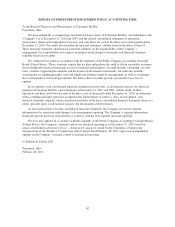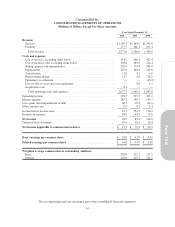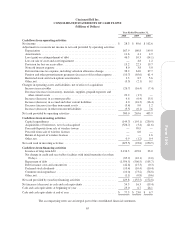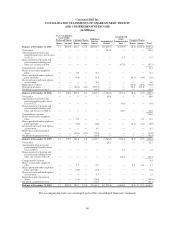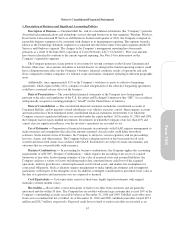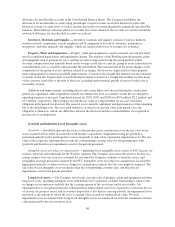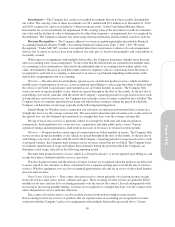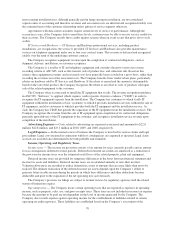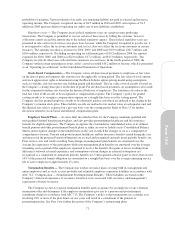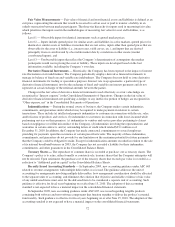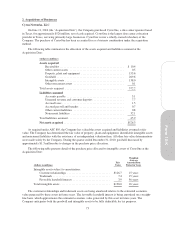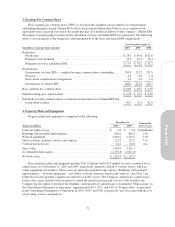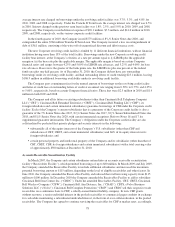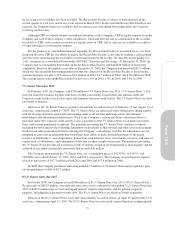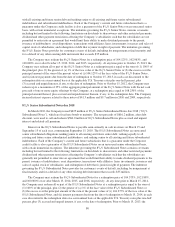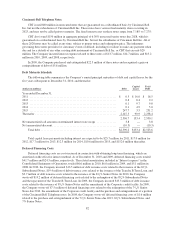Cincinnati Bell 2010 Annual Report Download - page 162
Download and view the complete annual report
Please find page 162 of the 2010 Cincinnati Bell annual report below. You can navigate through the pages in the report by either clicking on the pages listed below, or by using the keyword search tool below to find specific information within the annual report.Fair Value Measurements — Fair value of financial and non-financial assets and liabilities is defined as an
exit price, representing the amount that would be received to sell an asset or paid to transfer a liability in an
orderly transaction between market participants. The three-tier hierarchy for inputs used in measuring fair value,
which prioritizes the inputs used in the methodologies of measuring fair value for asset and liabilities, is as
follows:
Level 1 — Observable inputs for identical instruments such as quoted market prices;
Level 2 — Inputs include quoted prices for similar assets and liabilities in active markets, quoted prices for
identical or similar assets or liabilities in markets that are not active, inputs other than quoted prices that are
observable for the asset or liability (i.e., interest rates, yield curves, etc.), and inputs that are derived
principally from or corroborated by observable market data by correlation or other means (market
corroborated inputs); and
Level 3 — Unobservable inputs that reflect the Company’s determination of assumptions that market
participants would use in pricing the asset or liability. These inputs are developed based on the best
information available, including the Company’s own data.
Derivative Financial Instruments — Historically, the Company has been exposed to the impact of interest
rate fluctuations on its indebtedness. The Company periodically employs derivative financial instruments to
manage its balance of fixed rate and variable rate indebtedness. The Company does not hold or issue derivative
financial instruments for trading or speculative purposes. Interest rate swap agreements, a particular type of
derivative financial instrument, involve the exchange of fixed and variable rate interest payments and do not
represent an actual exchange of the notional amounts between the parties.
Changes in the fair value of derivative financial instruments used effectively as a fair value hedge are
recognized in “Interest expense” in the Consolidated Statements of Operations. Changes in the fair value of
derivative financial instruments not qualifying as hedges or any ineffective portion of hedges are recognized in
“Other expense, net” in the Consolidated Statements of Operations.
Indemnifications — During the normal course of business, the Company makes certain indemnities,
commitments, and guarantees under which it may be required to make payments in relation to certain
transactions. These include (a) intellectual property indemnities to customers in connection with the use, sales,
and/or license of products and services, (b) indemnities to customers in connection with losses incurred while
performing services on their premises, (c) indemnities to vendors and service providers pertaining to claims
based on negligence or willful misconduct of the Company, (d) indemnities involving the representations and
warranties in certain contracts, and (e) outstanding letters of credit which totaled $23.1 million as of
December 31, 2010. In addition, the Company has made contractual commitments to several employees
providing for payments upon the occurrence of certain prescribed events. The majority of these indemnities,
commitments, and guarantees do not provide for any limitation on the maximum potential for future payments
that the Company could be obligated to make. Except for indemnification amounts recorded in relation to the sale
of its national broadband business in 2003, the Company has not recorded a liability for these indemnities,
commitments, and other guarantees in the Consolidated Balance Sheets.
Treasury Shares — The repurchase of common shares is recorded at purchase cost as treasury shares. The
Company’s policy is to retire, either formally or constructively, treasury shares that the Company anticipates will
not be reissued. Upon retirement, the purchase cost of the treasury shares that exceeds par value is recorded as a
reduction to “Additional paid-in capital” in the Consolidated Balance Sheets.
Recently Issued Accounting Standards — In September 2009, new accounting guidance under ASC 605
related to revenue arrangements with multiple deliverables was issued. The guidance addresses the unit of
accounting for arrangements involving multiple deliverables, how arrangement consideration should be allocated
to the separate units of accounting, and eliminates the criterion that objective and reliable evidence of fair value
of any undelivered items must exist for the delivered item to be considered a separate unit of accounting. Such
guidance is effective for fiscal years beginning on or after June 15, 2010. The adoption of this accounting
standard is not expected to have a material impact on the consolidated financial statements.
In September 2009, new accounting guidance under ASC 605, was issued regarding tangible products
containing both software and non-software components that function together to deliver the product’s essential
functionality. Such guidance is effective for fiscal years beginning on or after June 15, 2010. The adoption of this
accounting standard is not expected to have a material impact on the consolidated financial statements.
72


